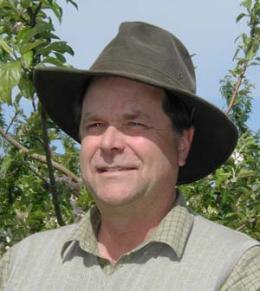Read the full text transcript (PDF) of the oral history with Sean Swezey.
 Sean Swezey. Photo by Bev Ransom--UC SAREP.
Sean Swezey. Photo by Bev Ransom--UC SAREP.As an entomologist and integrated pest management specialist, Sean Swezey has held a variety of demanding and influential posts. He has served as associate director of the Center for Agroecology and Sustainable Food Systems (CASFS) at UC Santa Cruz and director of the Davis-based University of California Sustainable Agriculture Research and Education Program (UC SAREP). He has held research and teaching appointments at UC Berkeley, Cornell University, and UC Santa Cruz. He has also worked as a consulting entomologist in Central and South America with the Organization of American States and with the Food and Agriculture Organization.
Swezey has helped pioneer organic growing techniques for several important California crops, successfully challenging entrenched assumptions about the inevitability of chemical-intensive production. He wrote and edited a University of California organic apple production manual—the first such manual for any organic commodity. He has advised a series of California Secretaries of Agriculture on the implementation and enforcement of the California Organic Foods Act of 1990. With UCSC agroecology professor Steve Gliessman, he helped establish one of the first organic farm advising services based at a university. In 2000, the Organic Farming Research Foundation’s (OFRF) Third Biennial National Organic Farmers’ Survey identified Swezey as the most frequently cited “Favorite University Researcher for organic production information.”
In this interview, conducted by Sarah Rabkin on November 24, 2008, at UCSC’s Program In Community and Agroecology, Sean Swezey discussed his training in biological pest control at UC Berkeley; his international advising; his research with transitional and organic apple, strawberry, artichoke, and cotton crops; his administrative work with UC SAREP; his collaborative work with farmers, and his university teaching.
After the recorded interview had concluded, Swezey shared his view of California’s Central Coast as a remarkable seedbed for the development and promotion of organic agriculture, saying, “I can’t think of a place that had as many thinkers, doers, and dreamers as Santa Cruz County. This was such a center. And [it’s not just] Santa Cruz County; there was Monterey… This is a fairly unique confluence. We had markets; we had the most accomplished commodity people—super-talented, visionary scientists and growers.”
Links:

 Santa Cruz, CA
Santa Cruz, CA



